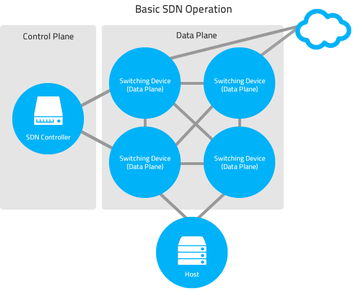The Open Networking Operating System (ONOS) project has deployed a router based on open source software in Australia and used it to communicate large volumes of data with a router in the USA.
This development is a big step forward for software-defined networking (SDN) because it shows that SDN-based routing can work internationally according to Dan Pitt, executive director of the Open Networking Foundation (ONF).
The basic operation of the SDN router
The SDN-based peering router, developed by the ONF and the ONOS Project, is a free, open-source application built on ONOS and downloadable from the ONOS Project website. It enables SDN-based IP networks to communicate with other networks – both SDN-based and non-SDN-based, by peering to collect and interpret information using Border Gateway Protocol (BGP).
The peering application receives route information from peers and programs the routing tables in the OpenFlow-based switch through ONOS.
In Australia the ONOS-based router was set up by the Australian Academic Research Network (AARNet) and the Commonwealth Scientific and Industrial Research Organisation (CSIRO). It was deployed across two sites in Sydney. OpenFlow switches supplied by Corsa Technology were located in an AARNet data centre in Haymarket, Australia, while the ONOS application, which controls the Corsa DP6410 data plane, runs in a CSIRO research laboratory approximately 15km away.
AARNet also provided the trans-Pacific connection to the US Department of Energy’s research Energy Sciences Network, ESnet, site in Berkeley, California, which hosts a Vandervecken router This is a complementary open source router based on technology developed under Google’s RouteFlow project. The ESnet site uses Corsa hardware.
Bill Snow, vice president of Engineering at ON.Lab said: “This operation has been up and running for over a month now, so there is no longer a question of whether SDN control planes can be deployed to support worldwide infrastructure.”
He continued: “With ONOS’ support for high availability, scale and performance and with Corsa’s, programmable data plane, the promise of SDN is turning into reality. An SDN control plane that readily interoperates with existing infrastructure, whether traditional or software-defined, is the key to providing a migration path from legacy systems as well as a roadmap to pure SDN infrastructure.”
A major step out of the data center
David Wilde, network architect for AARNet, Australia’s research network, said: “Much of the focus in SDN until now has been on networking within the data center, so it’s an important step forward to see this work across a wide-area network WAN.”
It is hoped that scalable controllers such as ONOS will allow carriers to develop applications for OpenFlow-based software-defined networks that lare vital to the large-scale adoption of SDN.
ONOS isn’t the only SDN controller, but it has been designed to handle services at the scale that, for example, telecommunications carriers need in their wide area networks.
According to the ON.Lab the main technical goal on this test was to program the data plane with large forwarding tables. The routers successfully exchanged 15,000 routes in this deployment - reflecting true Internet scale - and 100,000 routes have been programmed in lab tests it has said.


